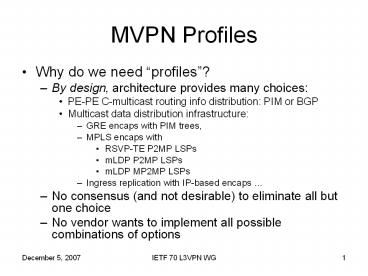MVPN Profiles - PowerPoint PPT Presentation
Title:
MVPN Profiles
Description:
PIM RD vector Join Attribute, for unsegmented inter-AS trees in 'vanilla' option ... Interesting Properties. Number of P-tunnels determined by number of PEs ... – PowerPoint PPT presentation
Number of Views:99
Avg rating:3.0/5.0
Title: MVPN Profiles
1
MVPN Profiles
- Why do we need profiles?
- By design, architecture provides many choices
- PE-PE C-multicast routing info distribution PIM
or BGP - Multicast data distribution infrastructure
- GRE encaps with PIM trees,
- MPLS encaps with
- RSVP-TE P2MP LSPs
- mLDP P2MP LSPs
- mLDP MP2MP LSPs
- Ingress replication with IP-based encaps
- No consensus (and not desirable) to eliminate all
but one choice - No vendor wants to implement all possible
combinations of options
2
Whats Good About Specifying Profiles?
- Profile A set of options which are
- useful together, and
- wanted by a customer
- Customer can ask for the profile it wants
- conformance to a profile is well-defined
- i.e., multi-vendor interoperability is possible.?
- Decisions can be based on customer demand, rather
than IETF debate.
3
FUD About Profiles
- Wouldnt it be better to have fewer options, or
even no options? - Only if you believe that one size fits all
- Only if theres enough real world experience to
show that only one set of options is needed - Only if theres real consensus behind a single
profile - Unless one profile is mandatory, theres no
guaranteed interoperability - In fact, it doesnt matter if one profile is
mandatory, unless thats the one that everyone
wants!
4
Profiles Using PIM Control Plane
- PIM? Oh, thats so passe! ?
- Some facts
- All existing deployments use PIM
- Not going away tomorrow
- One big advantage known to work, many years
experience behind it - Scalability issues do exist, but not even close
to approaching them in practice
5
Isnt BGP the new generation?
- WG docs do not favor either PIM or BGP over the
other - BGP for multicast new, experimental, with
certain risks - Increased J/P latency
- Impact on other uses of BGP
- Sparse Mode we think BGP handles sparse mode
okay, but there are some differences from PIM,
impact remains to be seen - Some customer deployments use PIM in odd ways
(e.g., use more control than data) that may not
fit well with BGP - BGP great at disseminating state, less great at
handling transactions - many PIM operations are transactional
- this caused the BGP solution to become more
complicated than originally envisaged, at least
by me
6
Profiles with PIM
- Primary Focus is one two profiles
- PIMGRE
- Existing deployments
- Really two sub-profiles
- Legacy sub-profile that corresponds exactly to
existing deployments - Fully standard sub-profile that provides PIMGRE
in a way which is fully compatible with WG docs - PIMMPLS
- We think MPLS data transport can provide a number
of advantages that make it useful with a PIM
control plane.
7
PIMGRE Profile
- Legacy sub-profile contains non-standard items,
specified in draft - MDT/SAFI, connector
- Replaced by Intra-AS AD Route and VRF Route
Import Extended Community in standards - PIM RDvector Join Attribute, for unsegmented
inter-AS trees in vanilla option B nets - IMHO should be added to WG standard, but has
gotten tangled up in the loose threads - Draft also specified fully standard PIMGRE
sub-profile
8
PIMMP2MP-LSP Profile
- PIM control plane is used
- MP2MP LSPs used for data and control packet
distribution - MI-PMSI required for PIM, but
- the P-tunnels instantiating the MI-PMSI are
created only as needed, - a PE joins a particular P-tunnel only as needed.
- No full mesh of P-tunnels
- unless needed anyway for data
9
MP2MP LSPs as P-Tunnels
- Each P-tunnel is MP2MP LSP rooted at a given PE
- To send a JP to a PE, join its MP2MP LSP and send
the JP on that LSP - Bidir joining based on RPA discovery, choose DF
based on upstream multicast hop selection for RPA - To send data to the other PEs
- Non-bidir send on the MP2MP LSP that you are the
root of - Bidir send on the MP2MP LSP rooted at the
selected DF? - N.B. If no one wants data from a particular PE,
the P-tunnel rooted at that PE is never created
10
Interesting Properties
- Number of P-tunnels determined by number of PEs
that have data to send - generally much smaller than total number of PEs
- therefore addresses PIM/MI-PMSI scalability
issues - When receiving data on MI-PMSI, can always
tell which PE transmitted it - inferred from LSP label, since only root
transmits data on LSP - data arriving from wrong upstream PE easily
discarded - makes efficient support of C-bidir possible
- eliminates need for single forwarder selection
- asserts never occur
- Does not require a second (upstream-assigned)
MPLS label - Still allows use of S-PMSIs as necessary
11
Future of This Draft
- Offered now as individual/informational
- Hopefully would progress to RFC after WG docs
- One might infer the interest of certain vendors
and customers in these profiles ? - WG might or might not decide to bless the notion
of profiles and standardize a few - In that case, we might want to reconsider the
role of this doc

